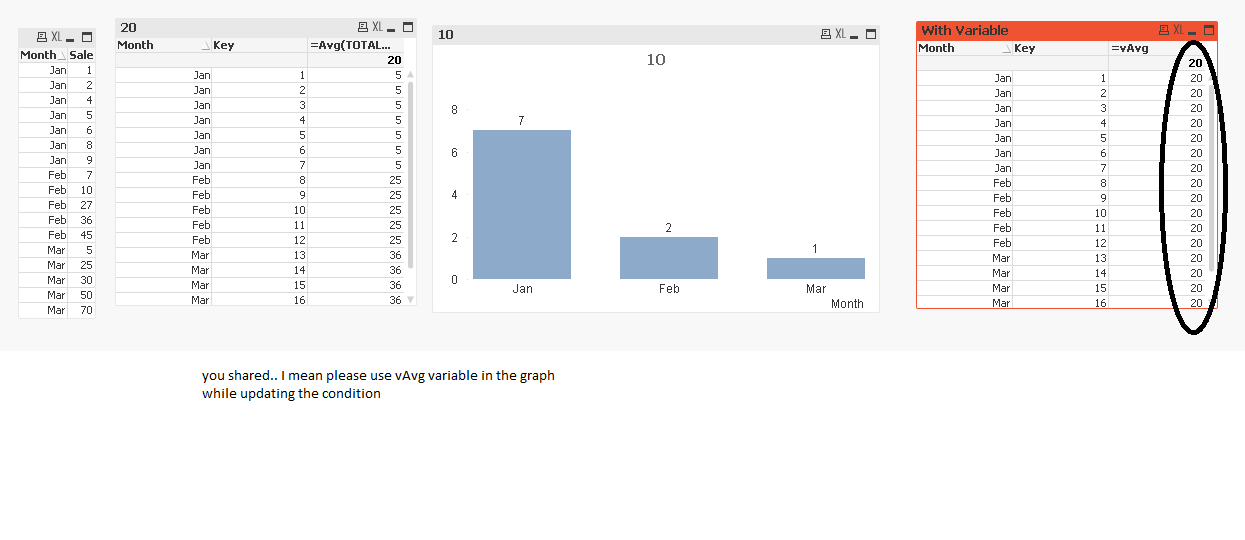Unlock a world of possibilities! Login now and discover the exclusive benefits awaiting you.
- Qlik Community
- :
- All Forums
- :
- QlikView App Dev
- :
- How to achieve the below task?
- Subscribe to RSS Feed
- Mark Topic as New
- Mark Topic as Read
- Float this Topic for Current User
- Bookmark
- Subscribe
- Mute
- Printer Friendly Page
- Mark as New
- Bookmark
- Subscribe
- Mute
- Subscribe to RSS Feed
- Permalink
- Report Inappropriate Content
How to achieve the below task?
Hi all,
I have the below scenario. Have a set of values for 3 months.
I want to get a count of values which are less than the average of all values for the month..
LOAD * INLINE [
Month, Sale
Jan, 2
Jan, 9
Jan, 4
Jan, 5
Jan, 6
Jan, 8
Jan, 1
Feb, 2
Feb, 3
Feb, 4
Feb, 5
Feb, 8
Mar, 6
Mar, 8
Mar, 1
Mar, 2
Mar, 3
];
How to plot a graph with Month as dimension and Count of values that are less than monthly average as a measure...
Avg of Jan 5, Feb 6, Mar 4 and overall is 5
The observation that I got when I wrote the code is it is for Feb it is not comparing the value against average of Feb (6) but comparing the values against the overall average 5..
The same is observed for all the aggregation functions.. Instead of comparing with the measure of that period , gets compared with the measure of all the time period..
How to avoid this behavior..
Regards,
Satya
- « Previous Replies
-
- 1
- 2
- Next Replies »
- Mark as New
- Bookmark
- Subscribe
- Mute
- Subscribe to RSS Feed
- Permalink
- Report Inappropriate Content
I am getting a different average for Feb = 4.4?
- Mark as New
- Bookmark
- Subscribe
- Mute
- Subscribe to RSS Feed
- Permalink
- Report Inappropriate Content
Try this script:
Table:
LOAD Month(Date#(Month, 'MMM')) as Month,
Sale,
RowNo() as Key;
LOAD * INLINE [
Month, Sale
Jan, 2
Jan, 9
Jan, 4
Jan, 5
Jan, 6
Jan, 8
Jan, 1
Feb, 2
Feb, 3
Feb, 4
Feb, 5
Feb, 8
Mar, 6
Mar, 8
Mar, 1
Mar, 2
Mar, 3
];
Dimension: Month
Expression:
=Count({<Key = {"=Sale < Avg(TOTAL <Month> Sale)"}>}Sale)
- Mark as New
- Bookmark
- Subscribe
- Mute
- Subscribe to RSS Feed
- Permalink
- Report Inappropriate Content
Hi Sunny,
Thank you for the rocket speed response. Can you explain the evaluation of the formula...
Alternate
I created a variable for average vAvg and want to pass this instead of writing the avg formula in the if statement..
How to modify your formula to accommodate the variable..
I have another scenario with Fractile function.. Hence thought of understanding your expression properly...with variable
Regards,
Satya
- Mark as New
- Bookmark
- Subscribe
- Mute
- Subscribe to RSS Feed
- Permalink
- Report Inappropriate Content
For each row (using RowNo() I have created a unique row), I am checking if Sale is less than Avg of sale for the month (Avg(TOTAL <Month> Sale)). If it is, then include the key, otherwise don't include it.
Does it make sense?
- Mark as New
- Bookmark
- Subscribe
- Mute
- Subscribe to RSS Feed
- Permalink
- Report Inappropriate Content
absolutely.. It makes sense.. I am trying to get the same result using variable !
Script..
Table:
LOAD Month(Date#(Month, 'MMM')) as Month,
Sale,
RowNo() as Key;
LOAD * INLINE [
Month, Sale
Jan,2
Jan,9
Jan,4
Jan,5
Jan,6
Jan,8
Jan,1
Feb,10
Feb,27
Feb,36
Feb,45
Feb,7
Mar,25
Mar,70
Mar,50
Mar,30
Mar,5
];
Variable vAvg= Avg(Sale)
Below is the image.. I need to use variable in the set analysis to fetch data ..Is it possible..
vAvg is always 20 in this case (irrespective of the month.) but my request is how to get the same values that you plotted in left table using the variable..

- Mark as New
- Bookmark
- Subscribe
- Mute
- Subscribe to RSS Feed
- Permalink
- Report Inappropriate Content
Check the updated file with the variable created
- Mark as New
- Bookmark
- Subscribe
- Mute
- Subscribe to RSS Feed
- Permalink
- Report Inappropriate Content
Fantabulous..
One thing , I am unable to understand is why to update Key = in set analysis..
what does it mean. (we are comparing sales value with Avg sales and what role does Key= play here..
Count({<Key = {"=Sale < $(vAvg)"}>}Sale)
- Mark as New
- Bookmark
- Subscribe
- Mute
- Subscribe to RSS Feed
- Permalink
- Report Inappropriate Content
In order to do a unique combination check, we need to have a unique key which can uniquely associate a month sale number to the Avg for the month. In this sample it was as simple as creating a unique key. In another instance you might be able to create another unique combination.
To see this, create a straight table with Key as your dimension and three expressions
1) Sale
2) $(vAvg)
3) =If(Sale < $(vAvg), Key)
You will see that the third expression will show only those keys which needs to be counted.
I hope this will help clarify some of the doubts
- Mark as New
- Bookmark
- Subscribe
- Mute
- Subscribe to RSS Feed
- Permalink
- Report Inappropriate Content
Hi Sunny,
![]() The solution is not working for the Fractile function. Can I have chat with you...
The solution is not working for the Fractile function. Can I have chat with you...
- « Previous Replies
-
- 1
- 2
- Next Replies »